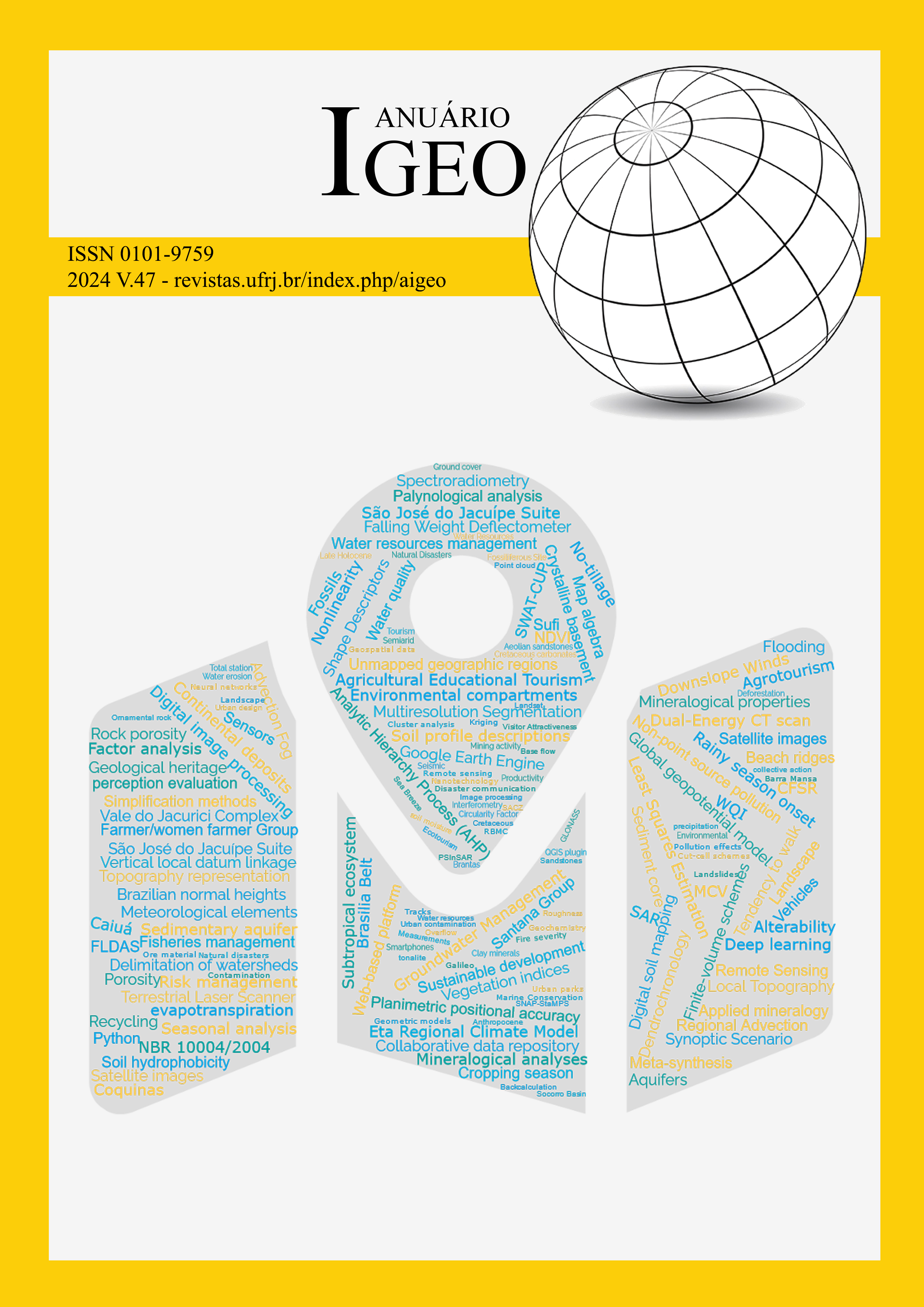Ecological Habit Inferences of the Extinct Porcupine Coendou magnus Lund, 1839 (Rodentia, Erethizontidae) from Brazilian Intertropical Region
DOI:
https://doi.org/10.11137/1982-3908_2024_47_60193Palavras-chave:
Paleoecology, Rodentia, South AmericaResumo
Through the use of two indices estimated from measurements of the humerus and ulna, we suggested the possible ecological habit of the extinct porcupine Coendou magnus Lund, 1839 from the Late Pleistocene in the Brazilian Intertropical Region. The analyzed specimen was found in Toca da Barriguda cave (Campo Formoso/BA, Brazil), weighed 9 kg, and lived in a low-density forest at 33,171-33,765 cal yr BP. All extant species of the Coendou genus are suspensory, and these indices suggest the same ecological habit for C. magnus.
Referências
Alves-Silva, L., Cherkinsky, A. & Dantas, MAT. 2023, `Late Pleistocene mammals from northeastern Brazil caves: Taxonomy, radiocarbon dating, isotopic paleoecology (δ13C), and paleoenvironment reconstruction (δ13C, δ18O)´, Quat Int (in press).
Dantas, MAT., Pansani, TR., Asevedo, L., Araújo, T., França, LM., Aragão, WS., Santos, FS., Cravo, E., Waldherr, FR. & Ximenes, CL. 2024, `Potential historically intertropical stable areas during the Late Quaternary of South America´, Journal of Quaternary Sciences, pp. 1-6.
Hoffstetter, R. 1963, `La faune Pleistocene de Tarija (Bolivie), note preliminaire´, Bulletin du Muséum national d'histoire naturelle, vol. 35, no. 2, 194e203.
Kerber, L., Mayer, EL., Ribeiro, AM. & Vucetich, MG. 2014, `Late Quaternary caviomorph rodents (Rodentia: Hystricognathi) from the Serra da Capivara, northeastern Brazil, with description of a new taxon´, Historical Biology, vol. 28, no. 4, pp. 439-458.
Lessa, G., Cartelle, C. & Manduca, EG. 2008, `Reevaluation of rodent assemblages from Pleistocene/Holocene of Bahia, Brazil: Morphologic and environmental considerations´, Resúmenes III Congreso Latinoamericano de Paleontología de Vertebrados, Neuquen, Argentina, p. 137.
Menezes, FH., Feijó, A., Fernandes‐Ferreira, H., Costa, IR. & Cordeiro‐Estrela, P. 2021, `Integrative systematics of Neotropical porcupines of Coendou prehensilis complex (Rodentia: Erethizontidae)´, Journal of Zoological Systematics and Evolutionary Research, vol. 59, no. 8, pp. 2410-2439.
Nascimento, ALDCP. & Santos, JW. 2013, `Coendou speratus Mendes Pontes, Gadelha, Melo, Sá, Loss, Caldara Jr., Costa & Leite, (Mammalia, Rodentia, Erethizontidae) in northeastern Brazil: Filling gaps in its geographical distribution´, Check List, vol. 10, no. 5, pp. 1223-1225.
Patel, BA., Ruff, CB., Simons, EL. & Organ, JM. 2013, `Humeral cross‐sectional shape in suspensory primates and sloths´, The Anatomical Record, vol. 296, no. 4, pp. 545-556.
Paula Couto, C. 1950, Memórias sobre a paleontologia brasileira, Instituto Nacional do Livro, Rio de Janeiro.
Reguero, MA., Candela, A. & Alonso, R. 2007, `Biochronology and biostratigraphy of the Uquía formation (Pliocenee early Pleistocene, NW Argentina) and its significance in the great American biotic interchange´, Journal of South American Earth Sciences, vol. 23, 1e16.
Santos, AMA., McDonald, HG. & Dantas, MAT. 2023, `Inferences about the ecological habits of the extinct giant sloths from Brazilian Intertropical Region´, Journal of Quaternary Science.
Sussman, DR., Croxen, FW., McDonald, HG. & Shaw, CA. 2016, `Fossil Porcupine (Mammalia, Rodentia, Erethizontidae) from El Golfo de Santa Clara, Sonora, Mexico, with a review of the taxonomy of the North American Erethizontids´, Contributions in Science, vol. 524, pp. 1-29.
Sussman, DR. 2011, `The erethizontid fossil from the Uquia Formation of Argentina should not be referred to the genus Erethizon´, Journal of South American Earth Sciences, vol. 31, 475e478.
Ubilla, M. 1996, `Paleozoología del Cuaternario continental de la Cuenca Norte del Uruguay: Biogeografía, Cronología y aspectos climatico-ambientales. [Paleozoology of continental Quaternary from Northern basin of Uruguay: Biostratigraphy, Chronology and environmental climatic aspect]´, PhD thesis, Facultad de Ciencias, Universidad de la República.
Vezzosi, RI. & Kerber, L. 2018, `The southernmost record of a large erethizontid rodent (Hystricomorpha: Erethizontoidae) in the Pleistocene of South America: Biogeographic and paleoenvironmental implications´, Journal of South American Earth Sciences, vol. 82, pp. 76-90.
Voss, RS., Hubbard, C. & Jansa, SA. 2013, `Phylogenetic relationships of New World porcupines (Rodentia, Erethizontidae): Implications for taxonomy, morphological evolution, and biogeography´, American Museum Novitates, vol. 3769, no. 3769, pp. 1-36.
White, JL. 1993, `Indicators of locomotor habits in xenarthrans: Evidence for locomotor heterogeneity among fossil sloths´, Journal of Vertebrate Paleontology, vol. 13, 2, pp. 230-242.
Downloads
Publicado
Edição
Seção
Licença
Copyright (c) 2024 Anuário do Instituto de Geociências

Este trabalho está licenciado sob uma licença Creative Commons Attribution 4.0 International License.
Os artigos publicados nesta revista se encontram sob a llicença Creative Commons — Atribuição 4.0 Internacional — CC BY 4.0, que permite o uso, distribuição e reprodução em qualquer meio, contanto que o trabalho original seja devidamente citado.
















 Exceto onde indicado de outra forma, o conteúdo deste site é licenciado sob uma licença
Exceto onde indicado de outra forma, o conteúdo deste site é licenciado sob uma licença 